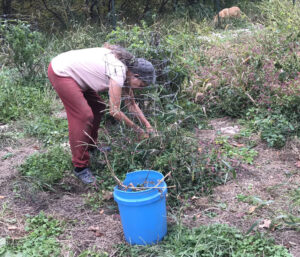- Like
- Digg
- Tumblr
- VKontakte
- Buffer
- Love This
- Odnoklassniki
- Meneame
- Blogger
- Amazon
- Yahoo Mail
- Gmail
- AOL
- Newsvine
- HackerNews
- Evernote
- MySpace
- Mail.ru
- Viadeo
- Line
- Comments
- SMS
- Viber
- Telegram
- Subscribe
- Facebook Messenger
- Kakao
- LiveJournal
- Yammer
- Edgar
- Fintel
- Mix
- Instapaper
- Copy Link
- Bluesky
A version of this column first ran in the Roane County (WV) Reporter and Times Record. Support local journalism! Subscribe to your local newspaper.
 Last fall I decided to move my raspberries from a bed in the garden to a new location. This makes the third start for those raspberries; I planted them originally in 2010 and then moved them, to renovate them, in 2018. They didn’t need renovation again after only three years, but I decided to move them because I wanted one more of my raised beds in my main garden; so I put my raspberries in another fenced space near my thornless blackberries.
Last fall I decided to move my raspberries from a bed in the garden to a new location. This makes the third start for those raspberries; I planted them originally in 2010 and then moved them, to renovate them, in 2018. They didn’t need renovation again after only three years, but I decided to move them because I wanted one more of my raised beds in my main garden; so I put my raspberries in another fenced space near my thornless blackberries.
Each time, I planted them about two feet apart; this time, the rows are four feet apart, which means I have room to move between them when picking, without having to make a trellis. They quickly fill in the space; I probably planted about sixteen plants three years ago and have now given away at least that many, plus the dozen I moved, and I have another dozen in a bucket, and I still have to dig the remaining half a bed. I plan to put potatoes there soon.
And this, dear reader, is where you come in. I will give you starts of these raspberries if you contact me and make arrangements to come collect them. You need to bring your own bucket to transport them in, and preferably have a place ready for them so they don’t have to survive in the bucket for long. If I don’t have contacts by Saturday the24th, I’m going to throw the rest into the woods.
So why would you want to go to the trouble? Because these are such productive plants, that’s why, and they don’t require much care. It’s worth preparing a good spot (preferably in full sun but half a day will do, if that’s the best you can muster), because you aren’t going to move them for at least six years. Meanwhile you can keep the soil fertility up by adding a little manure if you have it, and mulching them heavily with leaves every winter. You can use whole leaves for this; you don’t have to chop them.
They may need a little weeding, but with a heavy winter mulch and the speed with which they turn their space into a briarpatch, it isn’t all that much. You could provide a trellis but it isn’t necessary, unless they are in a confined space. They do have thorns. For this reason I usually cut them down to about six inches in the fall—but maybe I won’t do that in their new space, which isn’t close to other beds. They get about four feet tall.
Here I need to explain that these are everbearing raspberries—I don’t know the variety as I got them from my neighbor Robin who doesn’t pay attention to cultivar names. It’s an old, typical red raspberry. What “everbearing” means is that they begin producing berries in August and go until it freezes; then if you haven’t cut the canes, they produce again lightly in late June, halfway up the old canes. Whether you get a heavier fall harvest if you cut the old canes I don’t know. But I do know they are generally very productive. Harvesting is actually the main chore associated with them. I do it every other day, with a large metal bowl I set on the ground to toss handfuls of berries into, so I have both hands free. I wear long pants and shoes.
I resisted the idea of raspberries for years because the wild ones around here tend to be disease-ridden and unproductive, so I figured the cultivated ones would quickly succumb. Not so—the cultivated ones have better disease resistance than the wild ones (wouldn’t it be nice if the bees carry pollen conveying those resistance genes to the wild ones?).
The permaculture people are always harping on perennial plants, but few garden vegetables are perennials. The exceptions that are practical around here are mostly fruits—and rhubarb, which is a vegetable used as a fruit. I recommend getting a patch of that going too, if you like rhubarb.
What can you do with all those quarts of raspberries? Aside from fresh eating in cereal or yogurt, raspberries make a fine jam, and can be the basis of desserts like raspberry crisp. They freeze well.
Use the comment section for questions, objections and suggestions.
